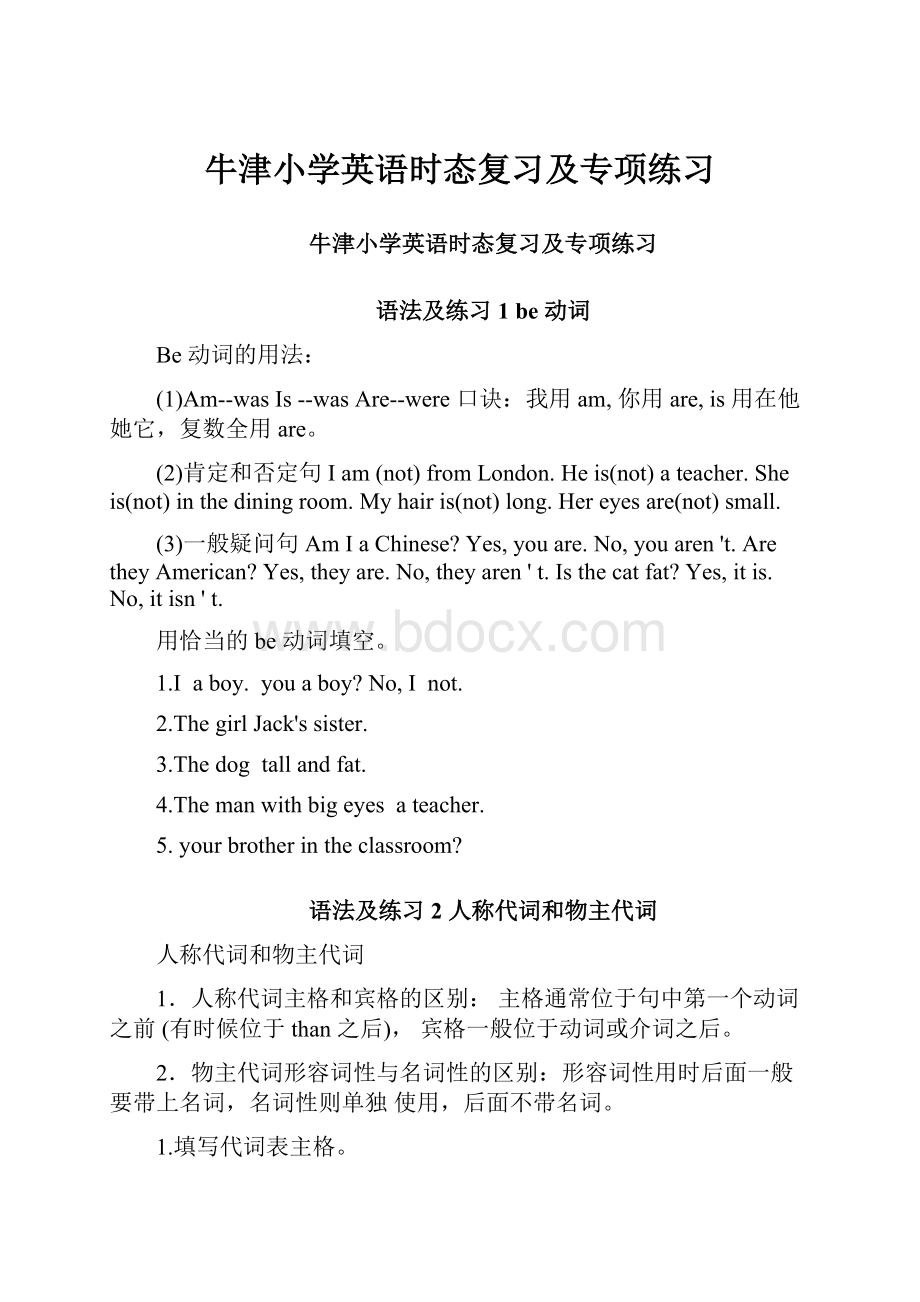牛津小学英语时态复习及专项练习.docx
《牛津小学英语时态复习及专项练习.docx》由会员分享,可在线阅读,更多相关《牛津小学英语时态复习及专项练习.docx(19页珍藏版)》请在冰豆网上搜索。

牛津小学英语时态复习及专项练习
牛津小学英语时态复习及专项练习
语法及练习1be动词
Be动词的用法:
(1)Am--wasIs--wasAre--were口诀:
我用am,你用are,is用在他她它,复数全用are。
(2)肯定和否定句Iam(not)fromLondon.Heis(not)ateacher.Sheis(not)inthediningroom.Myhairis(not)long.Hereyesare(not)small.
(3)一般疑问句AmIaChinese?
Yes,youare.No,youaren't.AretheyAmerican?
Yes,theyare.No,theyaren't.Isthecatfat?
Yes,itis.No,itisn't.
用恰当的be动词填空。
1.Iaboy.youaboy?
No,Inot.
2.ThegirlJack'ssister.
3.Thedogtallandfat.
4.Themanwithbigeyesateacher.
5.yourbrotherintheclassroom?
语法及练习2人称代词和物主代词
人称代词和物主代词
1.人称代词主格和宾格的区别:
主格通常位于句中第一个动词之前(有时候位于than之后),宾格一般位于动词或介词之后。
2.物主代词形容词性与名词性的区别:
形容词性用时后面一般要带上名词,名词性则单独使用,后面不带名词。
1.填写代词表主格。
Iitwe
youthem
hisyour
hers
2.用所给词的适当形式填空。
1.Thatisnotkite.Thatkiteisverysmall,butisverybig.(I)
2.Thedressis.Giveitto.(she)
3.Isthiswatch?
(you)No,it'snot.(I)
4.ismybrother.nameisJack.Look!
Thosestampsare.(he)
5.dressesarered.(we)Whatcolourare?
(you)
6.Herearemanydolls,whichoneis?
(she)
7.Icanfindmytoy,butwhere's?
(you)
8.Showyourkite,OK?
(they)
9.Ihaveabeautifulcat.nameisMimi.Thesecakesare.(it)
语法及练习3名词复数和动词三单
一、名词复数规则
1.一般情况下,直接加-S,如:
book-books,bag-bags,cat-cats,bed-beds
2.以s.x.sh.Ch结尾,力口-es,如:
bus-buses,box-boxes,brush-brushes,WatCh-WatCheS
3.以"辅音字母+y”结尾,变y为i,再力口-es,如:
family-families,StraWberry-StraWberrieS
4.以“f或fe”结尾,变f或fe为V,再加-es,如:
knife-knives
5.不规则名词复数:
man-men,woman-women,policeman-policemen,policewoman-policewomen,mouse-micechild-childrenfoot-feet,.tooth-teethfish-fish,people-people,Chinese-Chinese,Japanese-Japanese练习:
写出下列各词的复数。
I
__him
__this
__her
watch
__book
child___
photo
diary__
___day
__foot
dress_
tooth
___sheep
__box
__strawberry
thief_
yo-yo
peach___
___sandwich___
___man
woman
_paper
_people
.动词三单的变化规则
1.一般情况下,直接加-s,如:
cook-cooks,milk-milks
2.以s.x.sh.ch.o结尾,力口-es,如:
guess-guesses,wash-washes,watch-watches,go-goes
drink
___go
__stay
have
_pass
__carry
plant
_fly
__study
3.
练习:
写出下列动词的第三人称单数。
以"辅音字母+y”结尾,变y为i,再加-es,如:
StUdy-StUdieS
makelook
comewatch
brushteach语法及练习4一般现在时一般现在时一般现在时基本用法介绍一般现在时的功能
1.表示事物或人物的特征、状态。
如:
Theskyisblue.天空是蓝色的。
2.表示经常性或习惯性的动作。
如:
IgetUPatSiXeveryday.我每天六点起床。
3.表示客观现实。
如:
Theearthgoesaroundthesun.地球绕着太阳转。
一般现在时的构成
1.be动词:
主语+be(am,is,are)+其它。
如:
Iamaboy.我是一个男孩。
2.行为动词:
主语+行为动词什其它)。
如:
WeStUdyEnglish.我们学习英语。
当主语为第三人称单数(he,she,it)时,要在动词后加"-s"或"-es"。
如:
MarylikesChinese.玛丽喜欢汉语。
一般现在时的变化
1.be动词的变化。
否定句:
主语+be+nOt+其它。
如:
HeisnOtaworker.他不是工人。
一般疑问句:
Be+主语+其它。
如:
-Areyouastudent?
-Yes.Iam./No,I'mnot.特殊疑问句:
疑问词+一般疑问句。
如:
Whereismybike?
2.行为动词的变化。
否定句:
主语+don't(doesn't)+动词原形(+其它)。
如:
Idon'tlikebread.
当主语为第三人称单数时,要用doesn't构成否定句。
如:
Hedoesn'toftenplay.
一般疑问句:
Do(Does)+主语+动词原形+其它。
如:
-Doyouoftenplayfootball?
-Yes,Ido./No,Idon't.当主语为第三人称单数时,要用does构成一般疑问句。
如:
-Doesshegotoworkbybike?
-Yes,shedoes./No,shedoesn't.特殊疑问句:
疑问词+一般疑问句。
如:
Howdoesyourfathergotowork?
一般现在时用法专练:
一、用括号内动词的适当形式填空。
1.Heoften(have)dinnerathome.
2.DanielandTommy(be)inClassOne.
3.We(notwatch)TVonMonday.
4.Nick(notgo)tothezooonSunday.
5.they(like)theWorldCup?
6.Whattheyoften(do)onSaturdays?
7.yourparents(read)newspaperseveryday?
8.Thegirl(teach)usEnglishonSundays.
9.SheandI(take)awalktogethereveryevening.
10.There(be)somewaterinthebottle.
语法及练习5现在进行时
1.现在进行时表示现在正在进行或发生的动作,也可表示当前一段时间内的活动或现阶段正在进行的动作。
2.现在进行时的肯定句基本结构为be+动词ing.
3.现在进行时的否定句在be后加not。
4.现在进行时的一般疑问句把be动词调到句首。
5.现在进行时的特殊疑问的基本结构为:
疑问词不达意+be+主语+动词ing?
但疑问词当主语时其结构为:
疑问词不达意+be+动词ing?
动词加ing的变化规则
1.一般情况下,直接加ing,如:
cook-cooking
2.以不发音的e结尾,去e力口ing,如:
make-making,taste-tasting
3.如果末尾是一个元音字母和一个辅音字母,双写末尾的辅音字母,再加ing,如:
run-running,stop-stopping
现在进行时专项练习:
一、写出下列动词的现在分词:
play
___run
___swim_
like
___write
__ski___
sing
dance
___put___
love
live
take__
stop
sit
begin_
、用所给的动词的正确形式填空:
makego
readhave
seebuy
comeget
shop
1.Theboy(draw)apicturenow.
2.Listen.Somegirls(sing)intheclassroom.
3.Mymother(cook)somenicefoodnow.
4.Whatyou(do)now?
5.Look.They(have)anEnglishlesson.
6.They(not,water)theflowersnow.
7.Look!
thegirls(dance)intheclassroom.
8.Whatisourgranddaughterdoing?
She(listen)tomusic.
9.It's5o'clocknow.We(have)suppernow
10.Helen(wash)clothes?
Yes,sheis.
语法及练习6将来时
将来时
一、概念:
表示将要发生的动作或存在的状态及打算、计划或准备做某事。
句中一般有以下时间状语:
tomorrow,nextday(week,month,year,),soon,thedayaftertomorrow(后天)等。
二、基本结构:
①begoingto+do;②will+do.
三、否定句:
在be动词(am,is,are)l后加not或情态动词will后加not成won't。
例如:
I'mgoingtohaveapicnicthisafternoon.→I'mnotgoingtohaveapicnicthisafternoon.
四、一般疑问句:
be或WiIl提到句首,Some改为any,and改为or,第一二人称互换。
例如:
Wearegoingtogoonanoutingthisweekend.→Areyougoingtogoonanoutingthisweekend?
五、对划线部分提问:
一般情况,一般将来时的对划线部分有三种情况。
1.问人。
Who例如:
I'mgoingtoNewYorkSoon.→Who'SgoingtoNewYorkSoon.
2.问干什么。
What,do.例如:
MyfatheriSgoingtowatcharacewithmethiSafternoon.→
WhatiSyourfathergoingtodowithyouthiSafternoon.
3.问什么时候。
When.例如:
She'Sgoingtogotobedatnine.→WheniSShegoingtobed?
六、同义句:
begoingto=will
IamgoingtogoSwimmingtomorrow(明天).=IwillgoSwimmingtomorrow.
语法及练习7一般过去时
一般过去时
1.一般过去时表示过去某个时间发生的动作或存在的状态,常和表示过去的时间状语连用。
一般过去时也表示过去经常或反复发生的动作感谢。
2.Be动词在一般过去时中的变化:
⑴am和is在一般过去时中变为WaSO(WaSnot=wasn't)
⑵are在一般过去时中变为Were。
(Werenot=weren't)
⑶带有WaS或Were的句子,其否定、疑问的变化和is,am,are一样,即否定句在WaS或Were后加not,—般疑问句把WaS或Were调到句首。
3•句中没有be动词的一般过去时的句子
否定句:
didn't+动词原形,如:
Jimdidn'tgohomeyeSterday.
一般疑问句:
在句首加did,句子中的动词过去式变回原形。
如:
DidJimgohomeyeSterday?
特殊疑问句:
⑴疑问词+did+主语+动词原形?
如:
WhatdidJimdoyesterday?
⑵疑问词当主语时:
疑问词+动词过去式?
如:
WhoWenttohomeyesterday?
动词过去式变化规则:
1.一般在动词末尾加-ed,如:
pull-pulled,cook-cooked
2.结尾是e力口d,如:
taste-tasted
3.末尾只有一个元音字母和一个辅音字母的重读闭音节,应双写末尾的辅音字母,再加-ed,如:
stop-stopped
4.以"辅音字母+y”结尾的,变y为i,再加-ed,如:
StUdy-StUdied
5.不规则动词过去式:
am,is-Was,are-Were,do-did,see-saW,say-said,give-gave,get-got,go-Went,come-came,have-had,eat-ate,take-took,run-ran,Sing-Sang,put-put,make-made,read-read,Write-Wrote,draW-dreW,drink-drank,fly-fleW,ride-rode,Speak-Spoke,SWeep-SWept,SWim-SWam,Sit-Sat
过去时练习:
写出下列动词的过去式
is\am
fly
__plant
___are
___drink__
play
_go
___make
does
___dance
worry
___ask
_taste
___eat
draw__
put
throw
___kick
__pass
__do___
Be动词的过去时练习
一、用be动词的适当形式填空。
1.IanEnglishteachernow.
2.Shehappyyesterday.
3.Theygladtoseeeachotherlastmonth.
4.HelenandNancygoodfriends.
5.Thelittledogtwoyearsoldthisyear.
6.Look,therelotsofgrapeshere.
7.ThereasignonthechaironMonday.
8.
sDay.
TodaythesecondofJune.YesterdaythefirstofJune.ItChildren
Allthestudentsveryexcited.
二、句型转换。
1.Therewasacarinfrontofthehousejustnow.
否定句:
一般疑问句:
肯、否定回答:
过去时综合练习
(1)
一、用动词的适当形式填空。
1.It(be)Ben'sbirthdaylastFriday.
2.Weall(have)agoodtimelastnight.
3.He(jump)highonlastSportsDay.
4.Helen(milk)acowonFriday.
5.Shelikesnewspapers,butsheabookyesterday.(read)
6.Hefootballnow,buttheybasketballjustnow.(play)
7.Jim'smother(plant)treesjustnow.
8.they(sweep)theflooronSunday?
No,they.
9.I(watch)acartoononMonday.
10.We(go)toschoolonSunday.
过去时综合练习
一、用动词的适当形式填空。
1.It(be)the2ndofNovemberyesterday.MrWhite(go)tohisofficebycar.
2.GaoShan(put)thebookonhisheadamomentago.
3.Don'tthehouse.Mumityesterday.(clean)
4.Whatyoujustnow?
Isomehousework.(do)
5.They(make)akiteaweekago.
6.Iwanttoapples.Butmydadallofthemlastmonth.(pick)
7.hetheflowersthismorning?
Yes,he.(water)
8.She(be)aprettygirl.Look,she(do)Chinesedances.
9.Thestudentsoften(draw)somepicturesintheartroom.
10.What__
Mikedoonthefarm?
Hecows.(milk)
附动词过去时不规则变化形式
原型
过去式
中文释义
am
was
是(表示存在、状态等)
are
were
是(表示存在、状态等)
become
became
成为;变成
begin
began
开始
break
broke
打破
bring
brought
拿来;取来;带来
build
built
构筑;建造;建筑
buy
bought
购买;买
can
could
可以;能;可能;会
catch
caught
赶上(车船等);捕获
come
came
来;来到
cut
cut
切;割;削;剪
do/does
did
做;干;行动
draw
drew
画
drink
drank
喝;饮
drive
drove
开车;驾驶
eat
ate
吃
feel
felt
感到;觉得
find
found
寻找;查找
fly
flew
飞行
forget
forgot
忘记;忘却
get
got
变得
give
gave
给;授予
go
went
去
have/has
had
得(病);患(病);有;吃;饮
hear
heard
听见;听说
hide
hid
隐藏
is
was
是(表示存在、状态等)
keep
kept
保持;使保持某种状态
know
knew
知道;了解
leave
left
离去;出发
let
let
允许;让
lose
lost
失去;丧失
make
made
使;促使;迫使;做;制作
may
might
可能;可以
mean
meant
表示,,的意思;作,,的解释
meet
met
遇见;相逢
put
put
放;摆;装
read
read/e/
读;阅读
ride
rode
骑
ring
rang
(铃)响
rise
rose
上升
run
ran
跑;奔跑
say
said
说;讲
see
saw
看见
send
sent
发送;寄;派;遣
set
set
放,置
show
showed
出示;给,,看
shut
shut
关上(门、盖、窗户等)
sing
sang
唱;唱歌
sit
sat
坐
sleep
slept
睡;睡觉
speak
spoke
说;说话
swim
swam
游泳
take
took
搭乘;花费(时间);拿走;带到
teach
taught
教;讲授
tell
told
告诉;讲述
think
thought
想;思考
will
would
将要
win
won
赢;获胜
write
wrote
书写
am,is-was,
are-were,
do-did,go-went,see-saw,say-said,
give-gave,
swim-swam,sit-satget-got,come-came,have-had
eat-ate,
take-took,
run-ran,sing-sang,put-put,
read-read,
make-made,write-wrote,draw-